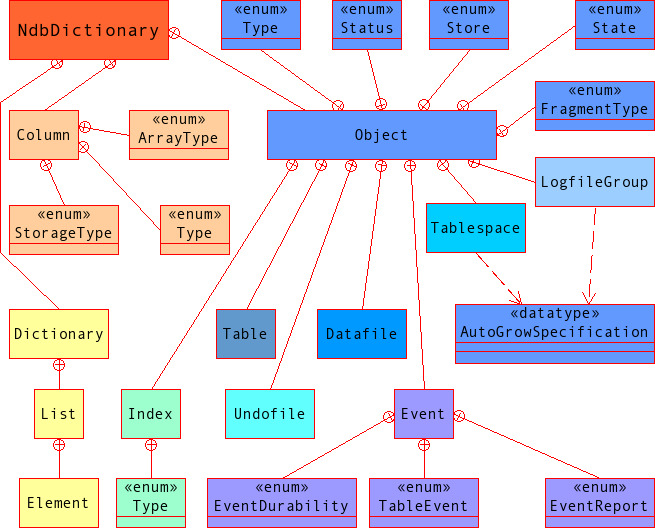- 2.3 NDB API Classes, Interfaces, and Structures
- 2.3.1 The Column Class
- 2.3.2 The Datafile Class
- 2.3.3 The Dictionary Class
- 2.3.4 The Event Class
- 2.3.5 The Index Class
- 2.3.6 The LogfileGroup Class
- 2.3.7 The List Class
- 2.3.8 The Ndb Class
- 2.3.9 The NdbBlob Class
- 2.3.10 The NdbDictionary Class
- 2.3.11 The NdbEventOperation Class
- 2.3.12 The NdbIndexOperation Class
- 2.3.13 The NdbIndexScanOperation Class
- 2.3.14 The NdbInterpretedCode Class
- 2.3.15 The NdbOperation Class
- 2.3.16 The NdbRecAttr Class
- 2.3.17 The NdbScanFilter Class
- 2.3.18 The NdbScanOperation Class
- 2.3.19 The NdbTransaction Class
- 2.3.20 The Object Class
- 2.3.21 The Table Class
- 2.3.22 The Tablespace Class
- 2.3.23 The Undofile Class
- 2.3.24 The Ndb_cluster_connection Class
- 2.3.25 The NdbRecord Interface
- 2.3.26 The AutoGrowSpecification Structure
- 2.3.27 The Element Structure
- 2.3.28 The GetValueSpec Structure
- 2.3.29 The IndexBound Structure
- 2.3.30 The Key_part_ptr Structure
- 2.3.31 The NdbError Structure
- 2.3.32 The OperationOptions Structure
- 2.3.33 The PartitionSpec Structure
- 2.3.34 The RecordSpecification Structure
- 2.3.35 The ScanOptions Structure
- 2.3.36 The SetValueSpec Structure
Abstract
This class provides meta-information about database objects, such as tables, columns, and indexes.
While the preferred method of database object creation and
deletion is through the MySQL Server,
NdbDictionary also permits the developer to
perform these tasks via the NDB API.
Parent class. None
Child classes. Dictionary, Column, Object
Description. This is a data dictionary class that supports enquiries about tables, columns, and indexes. It also provides ways to define these database objects and to remove them. Both sorts of functionality are supplied via inner classes that model these objects. These include the following:
NdbDictionary::Object::Tablefor working with tablesNdbDictionary::Columnfor creating table columnsNdbDictionary::Object::Indexfor working with secondary indexesNdbDictionary::Dictionaryfor creating database objects and making schema enquiriesNdbDictionary::Object::Eventfor working with events in the cluster.
Additional NdbDictionary::Object subclasses
model the tablespaces, logfile groups, datafiles, and undofiles
required for working with MySQL Cluster Disk Data tables
(introduced in MySQL 5.1).
Warning
Tables and indexes created using NdbDictionary
cannot be viewed from the MySQL Server.
Dropping indexes via the NDB API that were created originally from a MySQL Cluster causes inconsistencies. It is possible that a table from which one or more indexes have been dropped using the NDB API will no longer be usable by MySQL following such operations. In this event, the table must be dropped, and then re-created using MySQL to make it accessible to MySQL once more.
Methods.
NdbDictionary itself has no public methods. All
work is accomplished by accessing its subclasses and their public
members.
NdbDictionary Subclass Hierarchy.
This diagram shows the hierarchy made up of the
NdbDictionary class, its subclasses, and their
enumerated datatypes:

The next several sections discuss
NdbDictionary's subclasses and their public
members in detail. The organisation of these sections reflects
that of the NdbDictionary class hierarchy.
Note
For the numeric equivalents to enumerations of
NdbDictionary subclasses, see the file
/storage/ndb/include/ndbapi/NdbDictionary.hpp
in the MySQL Cluster source tree.
